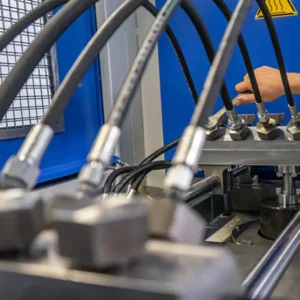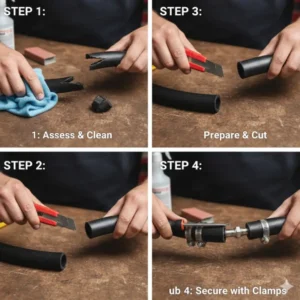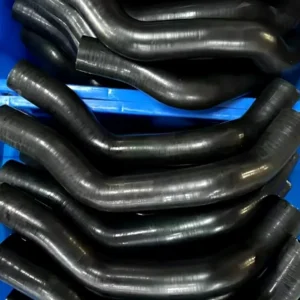When working with pressurized systems, whether it’s driving heavy machinery or fueling a grill, choosing the right hose is critical to safety and efficiency. A question we often get, especially among those looking for a versatile solution, is: Can hydraulic hoses be used with propane? This isn’t just a technical question; it’s a critical safety concern that requires a comprehensive and definitive answer.
Let’s explore why the seemingly simple question of hose interchangeability requires a detailed understanding of material science, regulatory standards, and the specific properties of hydraulic fluid and propane.
Applications of Hydraulic Hose
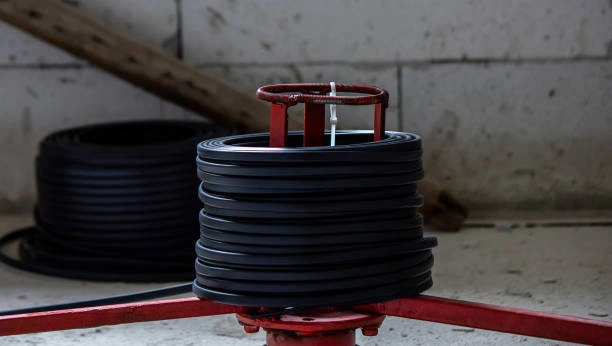
Hydraulic hoses are complex components that are typically made up of multiple layers. They consist of an inner tube that is compatible with the hydraulic fluid, a reinforcement layer (usually braided steel wire or synthetic fiber) to withstand the pressure, and an outer layer to protect against abrasion, weather, and chemicals. Their design ensures durability and leak-free operation even in the harsh conditions of machinery such as excavators, forklifts, and industrial presses.
Hydraulic systems rely on incompressible fluids (usually oil) to transmit power. These hoses are engineered to withstand extremely high internal pressures, often thousands of pounds per square inch (psi), and are constructed to accommodate the specific characteristics of hydraulic fluids.
What is Propane
Propane, also known as liquefied petroleum gas (LPG), is a versatile and widely used fuel, but its chemical and physical properties are very different from hydraulic fluid. Understanding these differences is key to answering the question of whether hydraulic hoses can be used with propane. Propane is stored as a liquid under pressure, but vaporizes into a gas when released. This phase change, combined with its flammability, presents unique challenges for hose compatibility and safety.
Unlike hydraulic fluid, which is incompressible, gaseous propane is extremely expandable and can penetrate materials not specifically designed to contain propane. The chemical composition of propane also means that it reacts with certain rubber compounds, causing the hose liner to degrade. If the hose degrades, it can cause leaks, which is extremely dangerous given the flammable and explosive properties of propane.
Why Compatibility Matters: The Science Behind Hose Selection
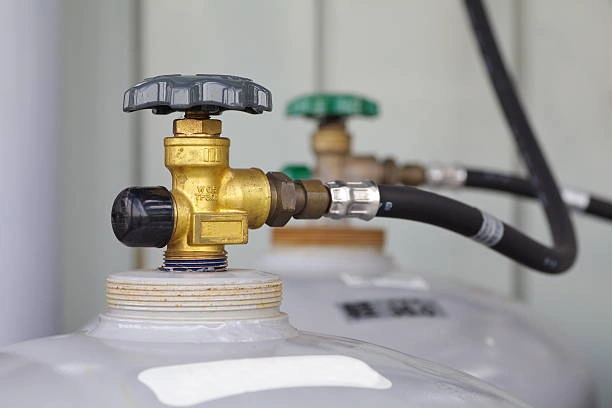
When we ask, “Can a hydraulic hose be used with propane?” we are asking about material compatibility and safety standards. Hoses are not general-purpose pipes, but highly specialized engineered products. Using a hose for something other than what it was designed for is asking for trouble. The core material, reinforcement, and outer covering of a hose are all selected based on specific fluid types, pressures, and environmental conditions.
Material Degradation
The most significant risk is material degradation. Hydraulic hose inner tubes are typically made from synthetic rubbers like nitrile (NBR) or chloroprene (CR), which are excellent for resisting petroleum-based hydraulic oils. However, propane, especially its liquid phase, can cause these materials to swell, crack, or become brittle over time.
This degradation compromises the hose’s structural integrity, leading to leaks or catastrophic failure. Even a tiny pinhole leak of propane is incredibly dangerous due to its flammability and tendency to pool in low areas.
Permeation
Propane molecules are small, and a hose not specifically designed for propane might allow these molecules to slowly permeate through the hose wall. While a hydraulic hose might appear intact, this slow permeation can lead to a buildup of flammable gas in confined spaces, posing an invisible yet serious explosion hazard. Hoses designed for propane have specialized inner linings to minimize this permeation.
Pressure Ratings and Temperature Ranges
While hydraulic hoses have high-pressure ratings, these ratings are for hydraulic fluid. The dynamic behavior of propane (liquid-to-gas phase change, specific gravity differences) means that even if a hydraulic hose has a high-pressure rating, it might not be suitable for the sustained or fluctuating pressures of propane without-specific testing and certification.
Temperature extremes can also affect hose performance, and propane hoses are designed to maintain their integrity across a wide range of operating temperatures, often colder than typical hydraulic applications.
Can Hydraulic Hose Be Used for Propane?
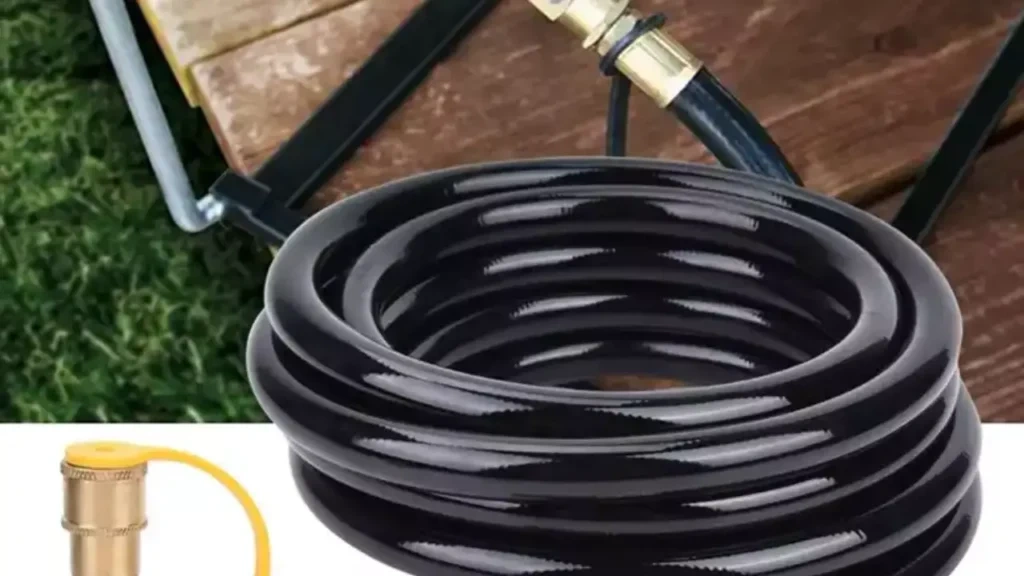
Hydraulic hoses should not be used to transfer propane; it is a serious safety violation and extremely dangerous. Using hydraulic hoses to transfer propane can result in serious consequences, including gas leaks, fire, explosion, serious injury, or even death.
| Feature | Hydraulic Hose (e.g., SAE 100R2) | Propane Hose (e.g., UL 21, NFPA 58) | Risk of Interchangeability (Hydraulic for Propane) |
| Primary Fluid | Hydraulic Oil (non-compressible liquid) | Propane/LPG (compressible liquid/gas) | High |
| Inner Tube Material | Nitrile, Chloroprene (Oil-resistant) | Specialty compounds (Propane-resistant, low permeation) | Degradation, swelling, cracking |
| Permeation | Moderate (less concern for non-flammable oil) | Very low (critical for flammable gas) | Flammable gas buildup, explosion risk |
| Pressure Rating | Very High (e.g., 3000-6000 psi) | Varies (often 350-500 psi working pressure) | Not primary concern, but material is |
| Flexibility | Designed for dynamic motion, specific bend radii | Designed for gas line flexibility, specific bend radii | Potential for early fatigue failure |
| Temperature Range | Typically -40°F to 250°F | Wider range, specifically for cold propane | Material embrittlement in cold |
| Safety Standards | SAE, ISO, DIN | UL, NFPA, CGA | Non-compliance, severe safety hazard |
The Importance of Certified Propane Hoses
If you cannot use a hydraulic hose, what should you use? The answer is simple: always use hoses specifically designed and certified for propane service. These hoses meet stringent safety standards established by organizations like Underwriters Laboratories (UL), the National Fire Protection Association (NFPA), and the Compressed Gas Association (CGA).
Key Features of a Propane-Approved Hose:
- Specialized Inner Tube: Made from compounds that resist propane’s chemical effects and minimize permeation.
- Reinforcement: Designed to handle the specific pressure characteristics of propane.
- Outer Cover: Often provides additional protection against abrasion, UV, and ozone.
- Markings and Certifications: Clearly labeled with “LPG,” “Propane,” and relevant certification marks (e.g., UL 21). We always check for these markings.
- Proper Fittings: Propane hoses use specific fittings that ensure a gas-tight seal, often different from those used in hydraulic systems.
Common Misconceptions and Dangerous Practices
We’ve observed several dangerous misconceptions that lead individuals to consider using hydraulic hoses for propane. Let’s debunk these myths to ensure everyone understands the gravity of proper hose selection.
- Myth 1: “It looks strong enough; hydraulic hoses handle high pressure.” While true for hydraulic fluid, pressure rating alone doesn’t equate to chemical compatibility or permeation resistance for propane. It’s like saying a heavy-duty water hose is safe for gasoline just because it handles water pressure.
- Myth 2: “It’s just for a temporary setup.” Even temporary misuse can lead to catastrophic failure. Propane leaks can escalate rapidly, especially in enclosed or poorly ventilated areas.
- Myth 3: “I’ll just try it and see if it leaks.” This is incredibly reckless. Propane leaks can be invisible and odorless (an odorant is added to make it detectable, but concentrations might be too low to smell, or the smell might dissipate). The first indication of a problem could be an explosion.
- Myth 4: “A hose is a hose.” This is the most dangerous misconception. As discussed, hoses are highly engineered components with specific material compositions and construction methods for their intended applications.
What Type of Hose Can Be Used for Propane?
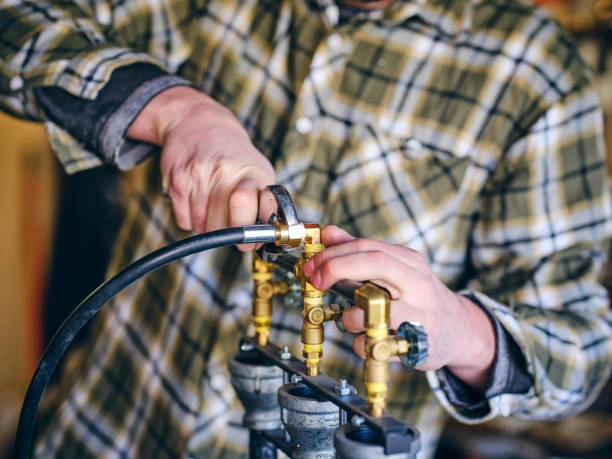
Beyond choosing the correct hose, proper installation and maintenance are vital for propane safety. As users, we have a responsibility to follow best practices diligently.
- Always Use Certified Hoses: As emphasized, this is non-negotiable. Look for clear markings indicating “LPG” or “Propane” and relevant safety certifications (UL, NFPA).
- Inspect Regularly: Before each use, or at least periodically, inspect your propane hoses for any signs of wear, cracks, bulges, abrasions, or leaks. A soapy water solution can be applied to connections to check for bubbles, indicating a leak.
- Proper Storage: Store hoses away from direct sunlight, extreme temperatures, and sharp objects. Kinking or crushing can damage the internal structure.
- Correct Fittings: Ensure all fittings are designed for propane, are clean, and are properly tightened. Never use thread sealants not rated for propane.
- Avoid Over-Tightening: Over-tightening can damage the hose end or fitting. Follow the manufacturer‘s torque specifications.
- Replace Damaged Hoses Immediately: If a hose shows any signs of damage or wear, replace it immediately with a new, certified propane hose. Do not attempt to repair it.
- Follow Manufacturer Instructions: Always adhere to the installation and maintenance guidelines provided by the hose and appliance manufacturers.
Conclusion
While hydraulic hoses are rugged and designed for high pressures, their material composition is simply incompatible with the chemical properties and permeation characteristics of propane.
When handling flammable gases such as propane, cutting corners when selecting hoses is not only unwise but extremely dangerous. We urge everyone to put safety first, understand the different requirements of different fluids, and always choose appropriate, certified equipment.

